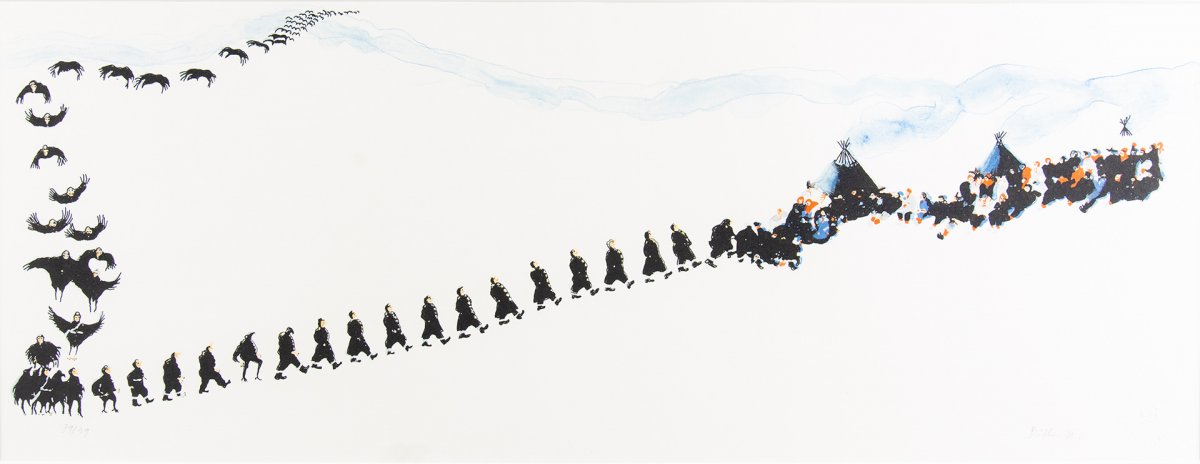
Britta Marakatt-Labba, "Gárjjat / The Crows". 1981 Embroidery, 100 x 40 cm. Courtesy of UiT - The Arctic Unversity of Norway
On 4 April at 6 pm
The workshop will take place online. Link to the meeting:
https://us02web.zoom.us/j/85709579495?pwd=SEhYWk0yK01WOVNVSXdVWVkzQWxPdz09
Meeting ID: 857 0957 9495
Passcode: 941470
Texts to be discussed:
Jan-Erik Lundstrom, “The Sápmi Lessons: Retoolment, Resurgence, and Re-existence in Indigenous Circumpolar Art.” In: Qummut Qukiria! Art, Culture, and Sovereignty Across Inuit Nunaat and Sápmi: Mobilizing the Circumpolar North. Eds. Anna Hudson, Heather Igloliorte, Jan-Erik Lundström. Goose Lane Editions, 2022, pp. 116–139.
James Clifford, “Among Histories.” In: Returns. Becoming Indigenous in the Twenty-First Century. Harvard University Press. 2013, pp. 13–49.
To receive the text, please email to: ieva.ast@gmail.com.
This reading workshop, organised in collaboration with art historian and curator Bart Pushaw, focuses on indigeneity issues, their resurgence in a global and regional context, as well as indigenous art and culture as forms of decoloniality and resistance.
“Indigenous people have emerged from history’s blind spot. No longer pathetic victims or noble messengers from lost worlds, they are visible actors in local, national, and global arenas. On every continent, survivors of colonial invasions and forced assimilation renew their cultural heritage and reconnect with lost lands. They struggle within dominant regimes that continue to belittle and misunderstand them, their very survival a form of resistance,” writes historian James Clifford.
“Posing the impossibility of separating aesthetic, social, material, and political decolonization, the artistic practices in focus dismantle the Kantian—colonial/modern—idea of art’s autonomy, the neo-liberal notions of art for art’s sake, and contemporary prohibitions on instrumentalizing art. Disassembling the dividers that separate art and world, individual and community, aesthetic and political modalities, traditional and modern, universal and contingent, Indigenous aesthetic practices work on two tangents—interventions aimed at history, land, community, society, and cosmologies on the one hand; interventions aimed at the art and culture world system itself on the other hand. Crucially, such breaking down of borders is not a process of reduction. The traffic is two-way: art cannot be reduced to nor separated from politics. And vice versa. Clearly, collectivity and community have been active and influential ingredients in contemporary art practices over the last decades, as well as practices mounting overall challenges to modernist paradigms of art. But Indigenous aesthetic practices are here building differentiated structures, where the creative powers of art are induced in political, social, or communal struggle, although not as distinct or isolated aesthetic experiences but as processes embedded and embroiled in the vernacular and daily life experience of both Indigenous people themselves as well as settlers/colonizers,” writes curator Jan-Erik Lundstrom.
Bart Pushaw is Mads Øvlisen Fellow in Art History at the University of Copenhagen and a researcher in the project “The Art of Nordic Colonialism: Writing Transcultural Art Histories.” His research lately focuses on the colonial Americas since 1700, with a particular emphasis on the Indigenous Arctic. He builds on his training in Nordic and Baltic studies to write global art histories that entangle the Nordic and Baltic countries with Alaska and Kalaallit Nunaat. Alongside Linda Kaljundi, Eha Komissarov, Ulrike Plath, and Tiiu Saadoja, he is a co-curator of the forthcoming exhibition “Art in the Age of the Anthropocene” opening at Kumu Art Museum in May 2023.
The workshop is part of the project “Reflecting Post-Socialism through Postcolonialism in the Baltics”, which analyses the imprints of post-socialism and post-colonialism in the Baltic region. The programme is curated by Ieva Astahovska and Linda Kaljundi.